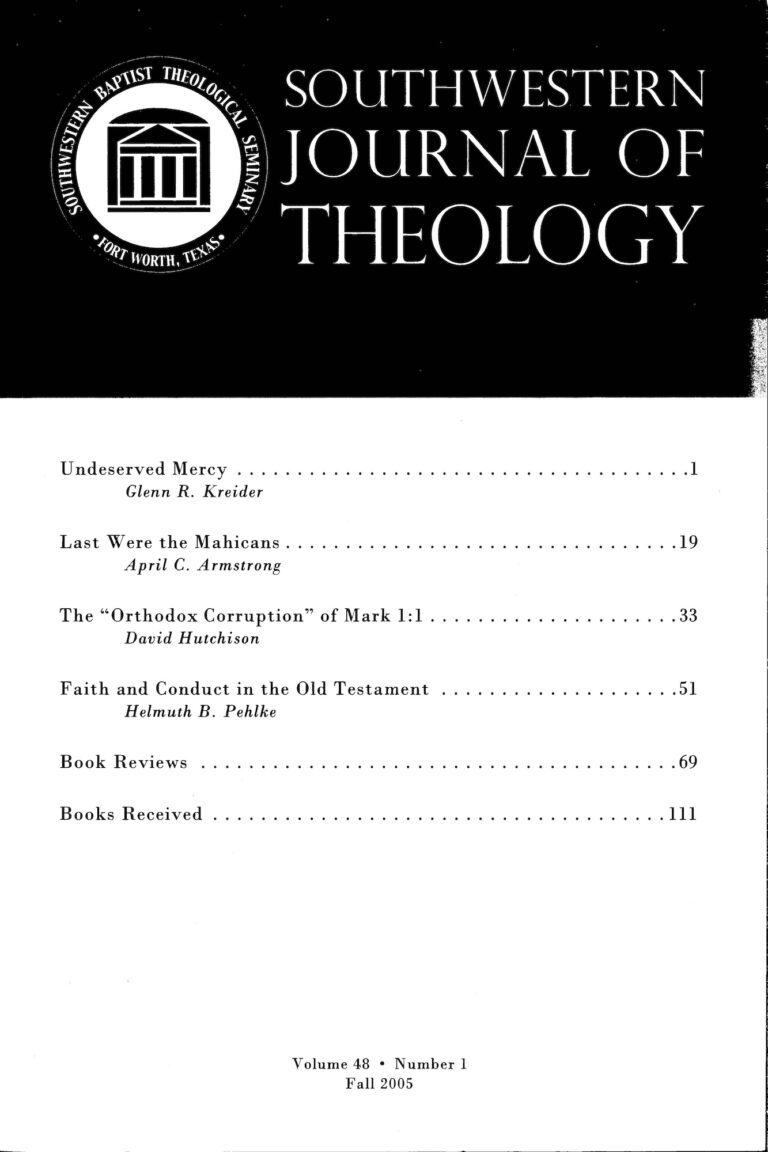
Southwestern Journal of Theology (48.1)
Southwestern Journal of Theology
Volume 48, No. 1 - Fall 2005
Editor: Paige Patterson
By Bruce J. Malina and John J. Pilch. Minneapolis: Augsburg Fortress, 2006. 419 pages. Softcover, $27.00.
In this commentary, Malina and Pilch have undertaken the noble task of establishing the first-century Mediterranean socio-historical context of seven Pauline letters they have identified as “authentic” (1-3). According to the authors, Paul functions as a “change agent” who redefines the boundaries of Judaism in terms of the social norms of the Jesus-group, or the ἐκκλησία (20-21). As a result, Paul then serves as a messenger to Israelites who live in the Diaspora “among the nations” rather than as an apostle to the nations themselves (17-20). Paul’s Jesus-groups operate within the Mediterranean patron-client system, whereby God functions as their benevolent benefactor, and group cohesion is maintained by cultivating an “honor-shame” mentality based upon communal mores and ethics.
Malina and Pilch have rightly focused on determining the socio-historical setting of the Pauline letters since they do indeed function as occasional documents which address specific groups with specific needs. To their credit, the authors have clearly stated their methodology and their presuppositions in the introduction and have abided by these principles throughout the rest of the work (28-29). In the “reading scenarios” at the end of the commentary, they also clearly define and categorize their terminology, thereby providing a helpful discussion for exegetes or students unfamiliar with social-scientific jargon (331-409).
Despite this clear organizational structure and concise writing, the book’s methodology does exhibit some fundamental flaws. For instance, the redefinition of the term ἔθνή as a designation for Israelites residing among non-Israelites proves problematic. First of all, the discussion of ἔθνή lacks proper research to show that it has the range to refer to Israelites rather than non-Israelites/Gentiles in the context of Hebraic or even early Christian literature. More importantly, the primary sources cited never discuss ἔθνή specifically and incorporate only Greek and Latin synonyms into the discussion along with other works by ancient historians that broadly comment upon the process of Hellenization (17-20). Second, Malina and Pilch themselves even use the term arbitrarily to mean both Israelite and non-Israelite depending upon the nature of their argument (197-98, 265). Above all, in this commentary the authors have succeeded only in proving that ethnocentrism existed in the ancient Mediterranean world and not the fact that ἔθνή refers to Israelites in the Diaspora.
Another fundamental problem in their methodology arises when they attempt to classify all the occasional aspects of a particular letter into rigid sociological categories which leave little room for distinctiveness or diversity. To Malina and Pilch, all Israelites seem to fit into two broad categories: those who practice Judean customs and those who do not (198). This categorization appears to oversimplify both the similarity and the diversity present within Jewish groups such as evidenced among the Sadducees, Pharisees, Essenes, and other sects. Moreover, the authors’ classification of Israelites into Judeans or Hellenists also appears to resurrect the debate concerning Palestinian versus Hellenistic Judaism which has long been laid to rest by Martin Hengel. Nevertheless, Malina and Pilch have reopened this debate primarily because it serves their purpose of redefining ἔθνή, not because any new or more convincing cultural evidence has surfaced.
Overall, the approach taken by this commentary reflects the new trend within scholarship to pay closer attention to the sociological and psychological background of biblical documents. In this work the reader does encounter some of the problems associated with the social-scientific approach, such as the use of modern social and psychological categories to explain first-century life and the apparent need to minimize the distinctions within various first-century cultural groups. Moreover, the problems associated with this methodology become most evident in this commentary when the authors attempt to redefine ἔθνή without much historical or linguistic warrant and then allow their new definition to guide their exegesis. Despite these methodological problems, one should read still read this commentary to gain a broader perspective of life in the ancient Mediterranean world and to keep abreast of current scholarly discussion in the New Testament field.





